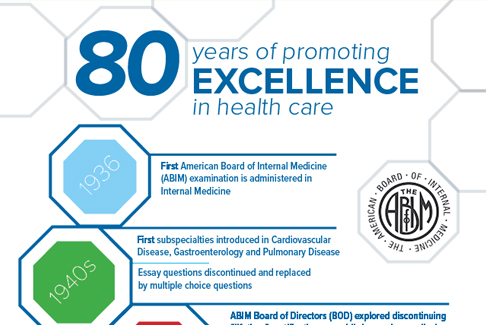This section will help you understand the difference between medical licensure and board certification as well as some of the process and terminology associated with obtaining and maintaining board certification.
“Board certification differs from medical licensure in important ways. Administered by state governments, licensure is quite broad: states allow licensed physicians to practice without restrictions, whether they are administering chemotherapy, replacing heart valves, or delivering babies. It is the profession that has created and applied higher standards for physicians who claim to have specialized knowledge. States don't regulate claims of special expertise, so we rely on board certification to verify that a physician has received specialized training and achieved and maintained knowledge and skills in a particular field. The medical profession has broadly embraced this credential: 79.1% of all licensed physicians in the United States are board certified by an American Board of Medical Specialties organization.”
--Drs. Richard J. Baron & Clarence H. Braddock III in “Knowing What We Don’t Know — Improving Maintenance of Certification” New England Journal of Medicine
What is licensure?
In order for a physician to practice medicine in the United States, they must obtain a medical license. A medical license is an occupational license that permits a person to legally practice medicine. It is not granted to just anyone with a medical degree. Rather, each state has determined a set of requirements for obtaining a license to practice in that state. Requirements vary among states, but in general, one must obtain:
- A medical doctorate from a U.S. or internationally accredited medical school.
- Certificate of completion of a medical residency training in an Accreditation for Graduate Medical Education accredited program.
- A passing score on a licensing exam such as the United States Medical Licensing Examination, Federation Licensing Examination or National Board of Medical Examiners.
A medical license must be maintained by remaining in good behavioral standing as well as completing a certain amount of Continuing Medical Education (CME) credits every year. The number of credits varies from state to state, but is usually around 50.
What is board certification?
Board Certification is a standard that was created to answer a public call to establish more uniform standards for physicians claiming specialized expertise in the medical field.
The American Board of Medical Specialties (ABMS) works in collaboration with 24 specialty Member Boards to maintain the standards for physician certification with the focus of improving the quality of health care for patients, families, and communities by supporting the continuous professional development of physician specialists.
For more than 80 years, the standards for medical specialty practice and certification has evolved to support advancements in medicine, science, and technology. As a community of learners and leaders, ABMS periodically evaluates and updates professional and educational standards to reflect the changes in medical specialty practice and health care delivery processes.
Certification by the American Board of Internal Medicine (ABIM) has meant that internists have demonstrated — to their peers and to the public — that they have the clinical judgment, skills and attitudes essential for the delivery of excellent patient care in a specific area of medicine.
ABIM's requirements for initial board certification include:
- A state medical license in good standing, with no restrictions.
- Successful completion of a residency or fellowship in the area in which the physician would like to specialize.
- Passing a certification exam in Internal Medicine and then a subspecialty certification exam for those who choose to further specialize.
A medical license is a requirement of board certification; board certification is not and cannot be a requirement of licensure because of this.
What is Maintenance of Certification?
After a physician is initially certified in a given specialty, they participate in ABIM's Maintenance of Certification (MOC) program. MOC provides doctors with a structured pathway to demonstrate they are staying current in the medical knowledge they use to treat patients and make important care decisions daily.
The requirements of ABIM’s MOC program include:
- Complete one approved activity at least every 2 years in order to be publicly reported as “Participating in MOC.”
- Earn at least 100 MOC points through these approved activities every 5 years in order to be reported as “Certified.”
- Take and pass a knowledge assessment at least every 10 years in order to be reported as “Certified.”
What's the difference between CME and MOC?
CME is a verification of participation in an educational activity; MOC is the demonstration that knowledge has been gained. While some educational activities for physicians count for both CME and MOC, the standards for MOC generally remain more stringent as board certification is a higher standard of demonstrated knowledge than licensure.
Infographics
Videos


